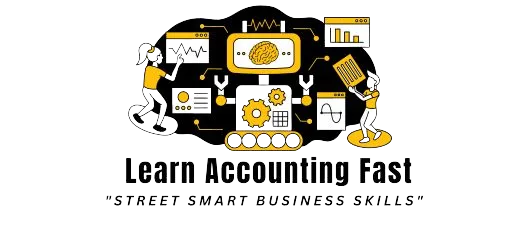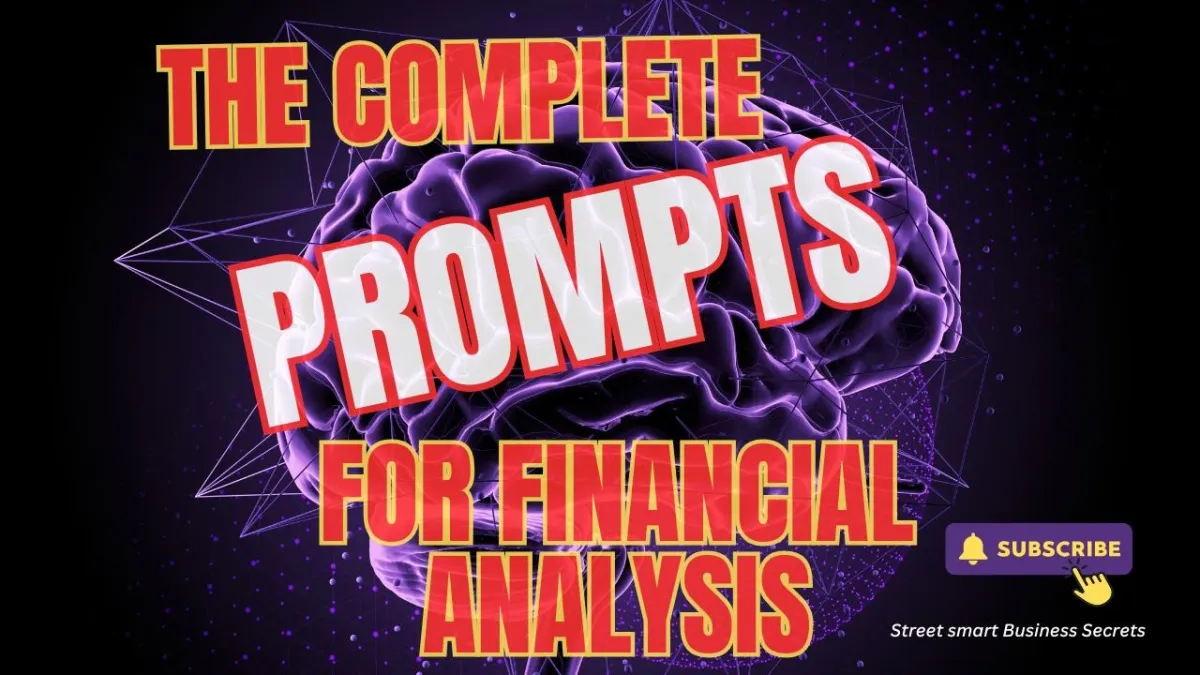Master Prompts For Financial Analysis
The Complete Small Business Guide to Financial Analysis: Formulas, Examples, and Tips
Easy-to-Use Expert Prompts for AI
These are super-powerful questions you can ask an AI to help you look closely at any company’s money reports.
They work for tiny family shops all the way up to giant companies like Berkshire Hathaway.
The AI will think like a mix between Warren Buffett (Financial Ratios Every Business Owner Should Know) and a top-level business accountant.
AI Prompts That Will Make Your Business Accounting Smarter.
Why use it?
So you can find the real story hidden in the numbers — the good, the bad, and the stuff most people miss.
Purpose: Use AI prompts to uncover hidden truths in financial statements, from mom-and-pop stores to global giants.
Tell the Ai who you are (example)
Add the following to the start of each of the analysis prompts to ensure accurate response from Ai.
You are a world-class financial controller and professional business analyst trained in the financial reporting style of Berkshire Hathaway, Warren Buffett, and Charlie Munger. Your job is to generate a report from this prompt to uncover the financial truth of a business using the financial reports attached.
SECTION 1: CORE PROFITABILITY PROMPTS
Profitability Analysis Made Simple. How to Know if Your Business is Truly Winning
Gross Profit Margin
Formula: (Revenue - COGS) ÷ Revenue × 100
Use: Reveals how much is left after production costs.
Example Prompt
You are a world-class financial controller and professional business analyst trained in the financial reporting style of Berkshire Hathaway, Warren Buffett, and Charlie Munger. Your job is to generate a report from this prompts to uncover the financial truth of a business using its reports.Gross Profit Margin
Formula: (Revenue - COGS) ÷ Revenue × 100
“Calculate gross profit margin for the last 5 years from the P&L. Is the margin consistent, rising, or falling? What do changes signal about operational control?”
Tip: If shrinking, ask: Are supplier costs rising? Are competitors cutting prices?
Net Profit Margin
Formula: Net Profit ÷ Revenue × 100
Prompt: “Extract net profit margin over the last 3 years. Explain drivers of change (expenses, tax, one-offs). Benchmark against competitors.”
Use this to assess actual profit left after everything is paid.
SECTION 2: OWNER RETURNS & VALUE CREATION
These metrics help you think like a long-term investor.
Return on Equity (ROE)
Formula: Net Income ÷ Avg. Shareholder Equity
Prompt: “Analyze ROE for the last 5 years. Decompose changes. Compare to Buffett’s 15%+ preference.
Warren Buffett loves high ROE without high debt.
Ask: Is it real growth or financial engineering, please explain.
Return on Invested Capital (ROIC)
Formula: Net Operating Profit After Tax ÷ (Debt + Equity – Cash)
Prompt:“Analyze 5-year ROIC trend. Compare to cost of capital and industry averages.”
Great businesses have a moat that keeps ROIC high and competitors out.
The Moat-ROIC Connection
If a business has a strong moat, it can:
Raise prices without losing customers
Avoid price wars
Spend less on marketing
Maintain efficiency even as it scales
As a result, the ROIC stays high over time, meaning they keep generating great returns on every dollar reinvested.
SECTION 3: LIQUIDITY & DEBT SAFETY
These metrics answer: Can the business survive the next storm?
Current Ratio
Formula: Current Assets ÷ Current Liabilities
Prompt: “Calculate the current ratio from the latest balance sheet. Flag if below 1.2 or unusually high.”
Healthy range: 1.5–2.0
Quick Ratio (Acid Test)
Formula: (Current Assets - Inventory) ÷ Current Liabilities
Prompt: “Provide quick ratio. Explain differences from current ratio. Is working capital liquid?”
Debt-to-Equity Ratio
Formula: Total Debt ÷ Total Equity
Prompt: “Extract debt-to-equity ratio. Is leverage rising or falling? Benchmark to industry.”
Question: Can the company service this debt if sales drop 30% tomorrow?
Interest Coverage Ratio
Formula: EBIT ÷ Interest Expense
Prompt: “Calculate interest coverage. Alert if below 2. What does this mean for debt safety?”
SECTION 4: OPERATIONS & EFFICIENCY
Business Efficiency Ratios That Predict Long-Term Success. Here’s how you detect cash traps and hidden inefficiencies.
Inventory Turnover
Formula: COGS ÷ Average Inventory
Prompt: “Assess inventory turnover. Is inventory moving or sitting? Any sign of cash lockup?”
Receivables Turnover
Formula: Net Credit Sales ÷ Avg. Accounts Receivable
Prompt: “Benchmark receivables turnover with industry. Flag any slow-paying customers.”
Asset Turnover Ratio
Formula: Revenue ÷ Avg. Total Assets
Prompt: “Evaluate asset turnover ratio vs. sector. Are assets earning their keep?”
SECTION 5: GROWTH & SCALABILITY
Revenue Growth Rate
Formula: (Current Revenue - Prior Revenue) ÷ Prior Revenue
Prompt: “Chart revenue growth for 5 years. Explain spikes or drops.”
EBITDA Growth
Formula: (Current EBITDA - Prior EBITDA) ÷ Prior EBITDA
Prompt: “Chart 5-year EBITDA growth. Identify operational drivers or red flags.”
Operating Cash Flow (OCF) Margin
Formula: Operating Cash Flow ÷ Revenue × 100
Prompt: “Extract OCF margin. Compare with net margin. Flag large gaps.”
Free Cash Flow (FCF)
Formula: Operating Cash Flow - Capital Expenditures
Prompt: “Calculate 5-year FCF. Is it consistent and growing? Any negative trends?”
Owner Earnings (Buffett Style)
Formula: Net Income + Depreciation & Amortisation – CapEx – Working Capital Changes
Prompt: “Calculate owner earnings. Is this truly distributable cash?”
SECTION 6: VALUATION & MARKET METRICS
Book Value per Share
Formula: (Total Equity – Preferred Equity) ÷ Shares
Prompt: “Extract book value per share trend. Is it rising? Any sign of value destruction?”
P/E Ratio
Formula: Share Price ÷ Earnings Per Share
Prompt: “Report P/E. Compare to peers. Does the valuation reflect optimism or trouble?”
Enterprise Value / EBITDA
Formula: (Market Cap + Debt - Cash) ÷ EBITDA
Prompt: “Benchmark EV/EBITDA against competitors. Any premiums or risks?”
SECTION 7: RISK FLAGS & FRAUD DETECTION
Altman Z-Score (Distress Risk)
Prompt: “Compute Altman Z-score. Is it below 1.8 (danger zone)? Break down contributing factors.”
Beneish M-Score (Fraud Risk)
Prompt:“Apply Beneish M-Score. Any earnings manipulation risks? Are there unexplained accruals?”
The Beneish M-Score is a financial forensic formula designed to catch companies that manipulate profits before it shows up in headlines or lawsuits.
Created by Professor Messod Beneish.
It's like a lie detector for accounting.
It doesn’t prove fraud — it tells you where to look deeper.
Think of it as:
If the numbers don’t walk like truth, talk like truth, or flow like truth — raise a red flag.”
PROMPTS (For Forensics & Insight)
These are your forensic accounting magnifying glasses.
“Run vertical & horizontal Profit & Loss analysis. Flag any unusual jumps.”
“Inspect depreciation schedules. Any sudden changes hiding profits?”
“Audit related-party transactions. Are they inflating short-term results?”
“Build rolling segmental margins. Are weak units being disguised?”
PRACTICAL APPLICATION EXAMPLES
For Small Business (Revenue <$5M)
“What are my gross & net margins vs. last year?”
“Does my free cash flow match profit?”
“Is my current ratio above 1.2? What happens if a client delays payment?”
“How many days of inventory do I hold?”
For Listed Corporates
"Chart ROE & ROIC trends. Is growth creating or destroying value?”
“Is one division propping up others? Run segmental analysis.”
“What’s our Enterprise Value/EBITDA vs. global competitors?”
Warren Buffett’s Wisdom Applied
“Accounting is the language of business.”
Buffett doesn’t just use numbers—he listens to them like a story. Use these prompts not as a checklist, but as a lens. Ask:
Are the profits real?
Are we converting earnings into cash?
Would I buy the whole business at this price?
NEXT ACTION STEPS
Copy These Prompts into Perplexity or ChatGPT
Test each with your company’s actual financials.Use Visual Tools
Platforms like Finbox, Koyfin, or TradingView make analysis fast.Build a Dashboard
Use Excel, Notion, or Airtable to track prompts, responses, and trends.Practice on Real Companies
Choose 1 great company (e.g., Apple), 1 struggling company (e.g., Peloton), and 1 startup.
Be the greatest you can be…
Join us, click the link below for short, sharp, simple video courses that give you confidence and street-smart business skills, to simplify business and accounting and focus on growing your business to succeed.
Latest Posts
The Six Laws of
Wealth Creation
The Six Laws of Wealth Creation. These timeless actions work in 2025’s rapid-change environment and give you calm, repeatable steps to grow money.....
How to Read Business
Financial Reports
A Story of Business Secrets Hidden in Reports
Sarah sat in her office staring at a thick folder of financial reports. Sales, costs, cash flow....
The Millionaire
Mind in Action
Timeless Wealth, Flow, and Power from Robert Kiyosaki,Frank Kern, Tony Robbins
and Open Ai......
Why Cost Control Is the Forgotten Key to Profitability
Most entrepreneurs chase sales growth like it’s the only thing that matters.They spend thousands on ads, new products, and fa ncy offices.....
Master Prompts For
Financial Analysis
The Complete Small Business Guide to Financial Analysis: Formulas, Examples, and Tips.These are super-powerful questions you can ask an AI to help..
How To Solve Any Business
Problem With Ai
AI can help you solve all of these faster, smarter, and more affordably, if you know how. This guide will show you exactly how to do that.........
Disclaimer: The content shared on this blog and in these videos is for informational and educational purposes only. Despite my 30 years of experience as a business owner, I am not a certified financial advisor, accountant, or legal professional. The insights and tips shared are based on personal experiences and should not be taken as professional financial or legal advice. For financial, legal, or professional advice, please consult with a certified professional in the respective field. I disclaim any liability or responsibility for actions taken based on any information found in this blog or these videos.
Copyright Learn Accounting Fast - All Rights Reserved 2025













Facebook
Instagram
X
LinkedIn
Youtube